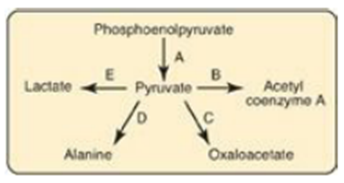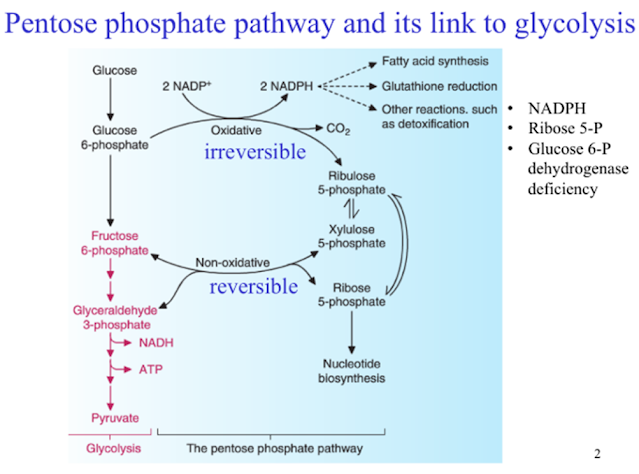CARBOHYDRATE METABOLISM - 02
1.Scheme of pyruvate metabolism.
2.
Metabolism of lactate. Cori’s cycle.
3.
Gluconeogenesis: metabolic precursors of glucose, scheme, biological role,
regulation.
4. Key
reactions of gluconeogenesis. Role of biotin.
Key
concept map for glycolysis.
Summary of the metabolic fates of pyruvate. TPP = thiamine
pyrophosphate. TCA = tricarboxylic acid; NAD(H) = nicotinamide adenine
dinucleotide; CoA = coenzyme A
2. Metabolism of
lactate. Cori’s cycle.
Cori
cycle
Lactate can
be further metabolized only by its reconversion to pyruvate.
Lactate and
pyruvate can readily diffuse out from the cells in which they are produced and
pass into the circulation.
From
circulation, they are removed by the liver and in liver cells they are
reconverted to form glucose and glycogen by gluconeogenesis.
This cycle
is referred to as Cori cycle.
3. Gluconeogenesis:
metabolic precursors of glucose, scheme, biological role, regulation
Gluconeogenesis
The process
of synthesizing glucose from noncarbohydrate precursors
The
major substrates:
-
glucogenic
amino acids,
-
lactate,
-
glycerol,
-
propionate
Tissues:
-
liver,
-
kidney,
-
small
intestine
Importance
of gluconeogenesis
•
Gluconeogenesis meets the needs of the body for glucose when insufficient
carbohydrate is available from the diet or glycogen reserves.
•
Gluconeogenesis removes lactate (produced by muscle and erythrocytes) and
glycerol (produced by adipose tissue).
Obligate
glucose users
-
Red
blood cells
-
Medulla
cells of the kidney
-
Activated
T-cells of the immune system
-
Sertoli
cells of the testis
Not
obligate users (preferring glucose)
-
Retinal
cells
-
Neurons
-
Fibroblasts
-
Smooth
muscle cells of vascular system
The liver,
kidney and intestines all contribute more or less to GNG.
This depends
on whether or not you’re eating and what you’re eating.
Many of the reaction steps involved in gluconeogenesis are catalyzed by the same enzymes that are used in glycolysis.
The non-reversible steps are bypassed with participation of specific to gluconeogenesis enzymes
4. Key reactions of
gluconeogenesis. Role of biotin.
Key
Reactions of Gluconeogenesis
01. Pyruvate
→ Oxaloacetate
-
a
biotin-dependent reaction catalyzed by pyruvate
carboxylase take place in the mitochondria
Biotin, a coenzyme: Pyruvate carboxylase
requires biotin (see p. 381) covalently bound to the ε-amino group of a lysine
residue in the enzyme (see Figure 10.3).
Hydrolysis of ATP drives the formation of an enzyme–biotin–CO2
intermediate, which subsequently carboxylates pyruvate to form OAA.
[Note: HCO3– is the source of the CO2.]
The pyruvate carboxylase reaction occurs in the mitochondria of
liver and kidney cells and has two purposes:
to provide an important substrate for gluconeogenesis and to
provide OAA that can replenish the TCA cycle intermediates that may become
depleted,
depending on the synthetic needs of the cell. Muscle cells also
contain pyruvate carboxylase but use the OAA produced only for the
replenishment (anaplerotic) purpose and do not synthesize glucose.
02. Oxaloacetate
→ Phosphoenolpyruvate
-
GTP-dependent
PEP carboxykinase take place in the cytoplasm
03. Fructose
1,6-bisphosphate → Fructose 6-phosphate
fructose
1,6-bisphosphatase is
an important regulation point in gluconeogenesis
I:
Fructose 2,6-bisphosphate
04. Glucose
6-phosphate → Glucose
glucose 6-phosphatase

















This comment has been removed by the author.
ReplyDelete